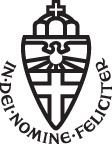Motto in English Happily in God's name Affiliation Roman Catholic Total enrollment 19,904 (2015) Phone +31 24 361 6161 Rector Han van Krieken | Established 17 October 1923 Academic staff 2,915 Founded 17 October 1923 | |
 | ||
Motto In Dei nomine feliciter Type private (publicly funded) Undergraduate tuition and fees Domestic tuition: 1,713 EUR (2011), International tuition: 8,913 EUR (2011) Notable alumni Similar University of Amsterdam, Utrecht University, Vrije Universiteit Amsterdam, University of Groningen, HAN University of Applie Profiles | ||
Radboud University Nijmegen (abbreviated as RU, Dutch: Radboud Universiteit Nijmegen, formerly Katholieke Universiteit Nijmegen) is a public university with a strong focus on research located in Nijmegen, the Netherlands. It was established on 17 October 1923 and is situated in the oldest city of the Netherlands. The RU has seven faculties and enrolls over 19,900 students. It was internationally ranked 156th by the QS World University Rankings.
Contents
- Terimakasih lpdp dari radboud university nijmegen
- History
- Campus
- Education
- International Masters programs
- Research
- University ranking
- Radboud Excellence Initiative
- Coat of arms
- Notable alumni
- Notable faculty
- References
Terimakasih lpdp dari radboud university nijmegen
History
The first Nijmegen University was founded in 1655 and terminated around 1680. The Radboud University Nijmegen was established in 1923 as the Katholieke Universiteit Nijmegen (Catholic University of Nijmegen) and started out with 27 professors and 189 students. It was founded because the Roman Catholic community wanted its own university. At the time, Roman Catholics in the Netherlands were disadvantaged and occupied almost no higher posts in government. After fierce competition with the cities of Den Bosch, Tilburg, The Hague, and Maastricht, Nijmegen was chosen to house the university. The subsequent Second World War hit the university hard. Many prominent members were lost, among them professors Robert Regout and Titus Brandsma. They were deported to Dachau concentration camp. In 1943, rector Hermesdorf refused to cooperate with the Germans. On 22 February 1944, the university lost many buildings in a bombardment. Classes resumed in March 1945. Since then, student numbers rose steadily from 3,000 in 1960 to 15,000 in 1980.
In 2004, the university changed its name to Radboud University Nijmegen, after Saint Radboud of Utrecht, a bishop who lived around 900.
Campus
The university's medical department is linked to the Radboud University Nijmegen Medical Centre, a large teaching hospital located on the Heyendaal campus along with the other university buildings such as the Huygensgebouw which contains the Natural Sciences. The Erasmus Tower and the Erasmusgebouw which contain the Faculty of Arts are situated at the south end of the campus next to the sports centre (USC). Recent building projects included new on-campus residence halls, the sports centre and several science buildings. The new Grotiusgebouw is recently built and will offer more room to the Faculty of Law. The university campus is located next to Heyendaal train station. Frequent shuttle buses connect the university to Nijmegen Central Station and the city centre.
Radboud University is noted for its green campus, often listed among the most attractive in the Netherlands.
Education
Radboud University has seven faculties and enrols over 19.900 students in 112 study programs (37 bachelor's and 75 master's programs).
As of September 2013, the university offers 36 international master's programs taught in English and several more taught in Dutch. There are two bachelor's programs taught fully in English: International Economics & Business and International Business Administration. All other bachelors are in Dutch, although most of the required literature is in English. Some exams, papers and even classes may be in English as well, despite the programs being Dutch-taught. All master's programs have been internationally accredited by the Accreditation Organization of the Netherlands and Flanders (NVAO).
International Master's programs
All English-taught Master's programmes are research-based programmes. They are taught within the Faculties of Arts, Law, Social Sciences, Medical Sciences, Sciences and Philosophy, Theology and Religious Studies, besides the Interfaculty Research school and the Nijmegen School of Management.
(Master's in italic are specialisations)
Research
Radboud University is home to several research institutions, including the Institute for Management Research, NanoLab Nijmegen, the Donders Institute for Brain, Cognition and Behaviour, the High Field Magnet Laboratory and the FELIX laboratory. Faculty members Anne Cutler (1999), Henk Barendregt (2002), Peter Hagoort (2005), Theo Rasing (2008), Heino Falcke (2011), Mike Jetten (2012), Ieke Moerdijk (2012), and Mikhail Katsnelson (2013) won the Spinoza Prize. Visiting professor Sir Andre Geim and former Ph.D. student Sir Konstantin Novoselov were awarded the 2010 Nobel Prize in Physics.
University ranking
The QS World University Rankings ranked the university 177th in the world in 2015. The university scored 45th in a 2012 ranking of European research universities.
In 2016, the Times Higher Education World University Rankings put the university in 125th place worldwide.
Radboud Excellence Initiative
The Radboud Excellence Initiative was created with the dual purposes of attracting talents from every academic field to Radboud University while strengthening international bonds between universities worldwide. The initiative is a joint enterprise of both Radboud University and Radboud University Medical Center. It provides two routes by which a researcher may come to Radboud University. Promising researchers who have completed their doctorate between two and twelve years at the point of nomination may be nominated for a fellowship whereas those researchers who are more established in their discipline may be nominated for a professorship.
Once selected, fellows may come to Radboud University to undertake research for a maximum of two years. Professors may come to Radboud University for a maximum period of six months.
Coat of arms
The coat of arms was designed at the time of the founding of the university by the goldsmith workshop of the Brom family in Utrecht. The lower part is the coat of arms of the Catholic Church in the Netherlands. The dove is the symbol of the Holy Spirit. The shield is surmounted by the crown of Charlemagne. Underneath is the motto "In Dei Nomine Feliciter."
